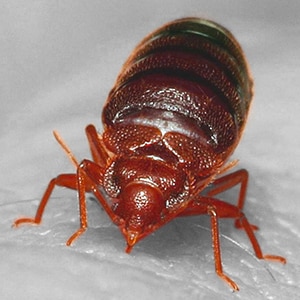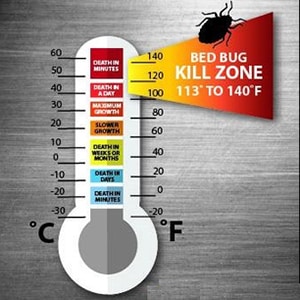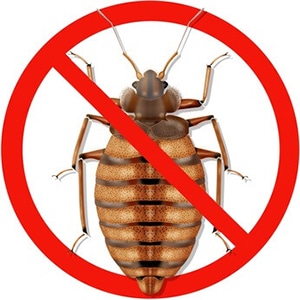
Bed bugs or Cimex lectularius are small flat parasitic insects that feed solely on the blood of humans but will feed on other warm-blooded animals while they sleep if no other food sources are present. Bed bugs in general are nocturnal but have been found to feed and be active during the day, usually near where a person may sleep or rest for long periods of time. Bed bug complaints and calls for information have been on the rise since the late ‘90s with infestations being found in residential homes, apartments and schools, businesses, movie theatres, senior living centres, health care facilities, furniture outlets, public transportation of all kinds, emergency vehicles and fire stations, libraries, churches, and wherever people socialize or congregate.
Bed bugs are small, oval, reddish—brown in colour, wingless and can live several months without a blood meal. Adult bed bugs are large enough to see with the naked eye, approximately the size of an apple seed. They have oval-shaped bodies, when unfed, and range from 1 mm to 7 mm long. Bed bugs have a short broad head and flat thorax. Despite having no wings, they can crawl quickly over floors, walls, and ceilings. Bed bugs cannot jump or fly. Prior to feeding, they are flat; however, after feeding with their piercing-sucking-type mouthparts, they turn dark red and appear elongated and bloated.
A female is capable of laying hundreds of eggs over her lifetime, depending on temperature and available hosts. The eggs are difficult to see, are pearl white, translucent in colour and display obvious eyespots of the nymph inside when 5 days or older. Eggs are usually laid in small clusters in cracks and crevices, eggs are laid using very sticky glue-like adhesive to a site and are very hard to remove by hand. Eggs can hatch anywhere from 3 to 10 days or longer depending on environmental conditions. The nymph stage, which looks like a small adult, is the immature stage of the bed bug, and they need to start to feed immediately. They molt 5 times with each stage ranging from 14 to 30 days. The entire life cycle from the first instar / nymph to adult is typically 4 to 9 weeks, dependent on environmental conditions and the availability of a host.

Dealing with bed bugs can be stressful, but at A1 Pest Solutions Inc, we handle it smoothly and efficiently. First, we thoroughly inspect your home to find where those pesky bugs are hiding. Then, we determine the best treatment process based on a number of factors specific to your situation. Our approach is tough on bugs but gentle on your living space, ensuring you can rest easy without any unwelcome guests.
At A1 Pest Solutions Inc, we understand how unsettling bed bug problems can be. That's why we offer expert extermination services to quickly and efficiently clear your home of these unwelcome guests, restoring your peace of mind and comfort.

The use of scent-detection dogs is an effective way of determining the presence of bed bugs in your home or business.
Bed bugs can be incredibly small and hide in a variety of places such as under carpets, behind baseboards, behind walls, within mattresses and box springs, as well as headboards and many other hard-to-access areas making it extremely difficult for human visual inspection to be effective.
A properly trained bed bug scent detection dog can effectively locate and identify a very small number of bed bugs of any life stage including viable eggs with a high degree of accuracy.

All bed bug treatments begin with A1 Pest Solutions Inc performing an inspection to customize the most effective and efficient pest control solution to eradicate your bed bug infestation.
Be aware not all “heat” treatments are thermal heat treatments. Thermal heat treatment is the gold standard of bed bug eradication. Thermal heat treatment involves A1 Pest Solutions Inc bringing in specially designed equipment to raise the temperature in your home to lethal bed bug temperatures killing all stages of the bed bug life cycle, including eggs, usually in only one treatment. Our specialized heaters will raise the temperature of all surfaces and items within the treatment area in a safe and controlled fashion to temperatures greater than 49°C / 120°F for a minimum of 2 hours all while being continuously monitored. During thermal heat treatment, the ambient air in the treatment area will generally reach temperatures between 54.5°C / 130°F and 60°C / 140°F.
This treatment will not only treat the structure but all items within, such as furniture, electronics, etc. saving you time and money having to replace your belongings.
Treatment times to perform thermal heat treatments will vary depending on the property being treated, most thermal heat treatments will usually be completed between 24 - 48 hours.
Prior to the treatment, you will be provided preparation instructions to prepare your home for thermal heat treatment as well as instructions for when returning home.
During thermal heat treatment pets and any heat-sensitive items that may melt or be damaged should be removed from the area being treated. Make sure you discuss this with your A1 Pest Solutions Inc representative as anything not treated with heat will need to be treated in another way or thoroughly inspected prior to being returned to the dwelling.
All A1 Pest Solutions Inc, thermal heat treatments include a pre-heat residual pesticide perimeter application throughout the home or treatment area unless otherwise requested by the customer.

Here at A1 Pest Solutions Inc, we now offer a natural, biopesticide called Aprehend. Aprehend is composed of Beauveria bassiana fungal spores applied in a proprietary and patented formulation to control bed bugs.
The treatment works by spraying Aprehend strategically in narrow strips, creating a barrier around areas where bed bugs are known to walk. When a bed bug walks across the Aprehend barrier, it picks up the fungal spores and carries them with it back to its nest or harbourage area. The spores are very easily transferred to other bed bugs. Within 20 hours of contact, the spores begin to germinate, penetrating the bed bug’s exoskeleton, allowing the spores to colonize inside the bed bug resulting in death. Bed bugs of all life stages and sex are killed within 4 to 10 days of contact with Aprehend. Due to its long-term activity, the Aprehend residue can provide up to 3 months of protection.
If you suspect a bed bug infestation in your home, the best starting point is to have a bed bug inspection completed.

The effectiveness of pesticide treatments for bed bugs varies greatly depending on the scale of the infestation, the preparation for treatment performed by the customer, and whether or not there is pesticide resistance in the bed bug infestation.
Residual pesticide treatments involve a minimum of 2 - 3 applications from A1 Pest Solutions Inc, as it is unlikely the eggs will be killed during the initial treatment due to their resistance to pesticides as well as the difficulties applying pesticides where they are laid.
Before any treatment, the A1 Pest Solutions Inc technician will provide you with detailed preparation instructions for how to prepare your home for treatment. It is very important to follow these directions closely, as properly preparing the home is an extremely important step in any treatment process. Improper preparation is one of the main reasons that pesticide treatment for bed bugs fails.
We strongly discourage the use of over-the-counter products for self-treatment of bed bug infestations, which may make your bed bug infestation more difficult to eradicate.

At A1 Pest Solutions Inc we understand how upsetting and mentally exhausting bed bugs can be.
Let our friendly, knowledgeable, fully licensed and insured staff find your pest management solution and eliminate your bed bug infestation today.
We offer several bed bug treatment options to fit your budget.
Please call or e-mail bed bug exterminator Winnipeg to find out which treatment option will work best for you.
Bed bugs can live anywhere but prefer places close to where people sleep. They typically hide in mattresses, bed frames, headboards, and nearby furniture. They can also be found behind wallpapers, under carpets, and inside electrical outlets.
Aside from bite symptoms, signs include fecal spots (small dark sand-like droppings that occur in patches around and especially beneath nests), blood smears on sheets (fecal spots that are re-wetted will smear like fresh blood), and the presence of their empty moulted exoskeletons.
Bed bugs and eggs are inadvertently on people visiting an infested area (e.g. dwelling, means of transport, entertainment venue, or lodging) and carrying the bugs to another area on their clothing, luggage, or bodies. Bed bugs are increasingly found in air travel.
Although bed bugs don't transmit diseases that impact your health directly, they can still cause significant health issues. The most apparent issue is their bites, which often result in red, itchy marks and rashes. Individuals who are more sensitive might develop hives, and in rare cases, the allergic reaction can escalate to anaphylaxis, a severe emergency. Scratching the bites can also lead to skin infections if the skin is broken and bacteria get in. In extreme cases of infestation, the volume of blood loss can even cause anemia.
The psychological impact of bed bugs can be profound. The incessant itching and the ongoing concern about further bites can greatly increase stress, disrupt sleep, and lead to chronic anxiety. In severe situations, individuals may develop delusional parasitosis, where they believe they are infested with parasites even when there are none. The emotional strain is magnified for families, as watching loved ones suffer adds an additional layer of distress.
To kill bed bugs effectively, it's recommended to combine heat treatment, chemical sprays, steam cleaning, and thorough vacuuming. Using mattress encasements can also help by trapping any remaining bugs and preventing further infestation. It is strongly recommended to consult a professional exterminator to ensure a comprehensive and effective eradication specific to your infestation.